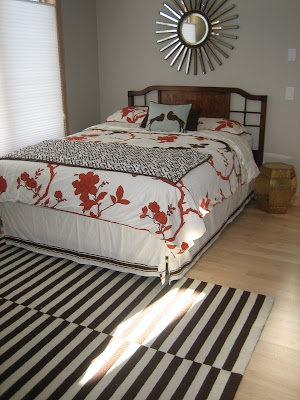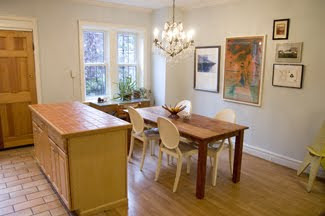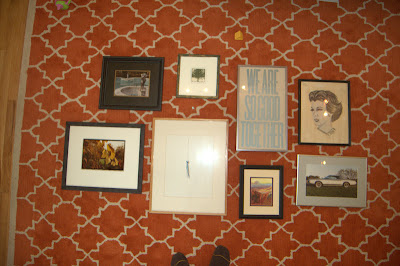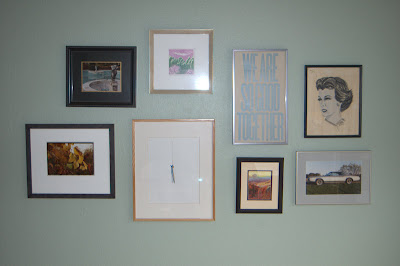When we moved in to this house, I had visions for most of the rooms, and had a mental list of where we would need to invest in some new pieces and where we could use what we had.
I was wrong about almost all of it.
Take the dining room. Our dining room contains some of my absolute favorite pieces: a beautiful Chinese armoire, handed down from my parents, a beautiful solid cherry wood farm table, made by hand by my father-in-law, and a set of four Phillipe Starck Ghost Chairs, the only big furniture purchase Dave and I made together in the Brooklyn 30th street house, a splurge we saved for for a long time. Plus we had a decent neutral rug and plenty of art and accessories to choose from. I thought we were set. But I got it all in and realized something: the scale was all wrong. The table was too small. The rug was way too small. And now that we live where we know a lot more people, the number of chairs was too, too small.
Tackling the seating problem, I just couldn't make the room add up. I considered an upholstered banquette, a pair of wing chairs to anchor the table, a pair of upholstered chairs AND a long lacquered bench. But most of those scenarios still yielded 6-8 seats, and some STILL required the purchase of an additional Ghost Chair (or two). Did I mention the price has gone up on those things TWICE since we bought them?
Then, trolling craiglist for a dresser for the guest room, opportunity knocked. Someone in Wisconsin was selling a set of 8 original Herman Miller fiberglass shell chairs. They were teal. I got excited, then forgot about them. I really wanted to incorporate my Ghost chairs into the scheme, right? Later that night, looking for something online, I noticed the tab still open, and showed it to Dave.
"Okay, don't tell me I'm crazy, but what do you think about these?" I asked. "For the dining room."
"Hm. I like them," He said. (You have no idea: normally I research for days, sit him down and show him a bunch of tabs, and he rejects everything.)
The next day we drove to Stillwater and just over the bridge to Wisconsin where we met Ron, a 3-decades employee of 3M who bought a palette of these chairs when the company was selling them off. They've been in the garage for years, but now he's selling his mother's house. So.
Normally, I think it's great to see a thing in your house before you have to commit to it. Color can be deceiving, and scale, especially if you're looking at a piece of furniture in a vast warehouse or flea market or a small dark garage where your point of reference is way off from your reality at home. Generally, with vintage, you have to decide on the spot.
We bought the chairs, but on our way home with the first half of them in the car, Dave wondered aloud: "Did we just repeat the yellow chairs?" The yellow chairs being a set of four mid-century leather and chrome chairs that we bought when we first moved in together. Dave was obsessed with them, I was fine with them, they were all piled onto a table in a cramped antique shop on Atlantic Avenue and after we bought them we discovered that the legs were a bit warped, the seats a bit scratched, and Dave was pissed off every time he sat in one of them. We had them just under a year and then sold them at a loss when we moved to the house on 30th street.
As it is turning out, I'm loving the Eames chairs in the dining room, and any fears that we overpaid are quelled by a quick search of ebay, where the chairs start high and then skyrocket, and where sets of 8 are exceedingly rare. There are some scratches that we'll have to learn not to see, and we'll spend a little money replacing some of the feet, but I think we still got a good deal, and the seller got a fair price. This is one of the goals in buying vintage.
It could have worked out differently, though. The teal could have been hideous in context, the feet exorbitantly expensive, the scale all wrong for the room, etc. Then we would have had an expensive mistake on our hands, and we would have been on ebay trying to sell them off again. So I thought I would share some tips on buying vintage. Consider these the Lessons I Refuse to Learn.
1. Do your research. While it can feel like there is the pressure of losing out on a purchase if you wait, you usually have time to do a little research. In our case, before heading out to see the chairs we should have checked out the going rate on ebay (although I had a sense of it from looking for one of these chairs in Boulder), as well as looked into the price of replacement parts so I would know what I was dealing with. If we had know that replacement feet cost $25/set of 4, we could have negotiated a better price on the chairs. The more you know, the more you will feel confident in your offer, and the less regrets you'll have later, whether you ultimately get the piece or not.
2. With small items (small price tag and physically small), buy what you love. You'll find a place for it.
3. Take a picture. This serves two purposes: it allows you to see the piece from a different perspective, and it allows you to sit on it and "bring it home" if you can't physically bring it home.
4. Ask to take it home. You likely can't do this with anything particularly large, but it's worth asking. I recently brought home two 1960s painted portraits on 24-hour approval. It took the pressure off the purchase and allowed me to decide if I really loved them or if I just felt I had to because now they were mine. (I kept them)
5. Even in an antique store, ask if the price is firm. There's often room to negotiate, but be reasonable. You want everyone to walk away happy.
6. Don't carry a lot of cash. If you love a piece, you can ask the seller to hold it while you get money. This cuts down on impulse purchases and allows you to walk away and consider.
7. Inspect the piece carefully before handing over the money. I've made this mistake more than once, either because I didn't want to hurt the seller's feelings or because I got nervous in the negotiation or because the piece was against a wall/on a table/in the dark. Take your time!
- Check the BACKS of things (I once bought a dresser that turned out to be water stained on the back)
- Check the legs, which can be chipped or broken (I recently bought a small side table that turned out to have a chunk of wood missing on one leg)
- Check the UNDERSIDES for rust or water damage (okay, this one has never happened to me, but it sure could)
- Sit in chairs, and put them on the flattest surface you can find to make sure they are level (a la the yellow chairs)
If a dealer isn't willing to let you pull out, sit in, or turn upside down a piece of furniture, walk away.
7. Make an offer, then don't nickel and dime. Once, in a Paris flea market, I forgot the conversion rate (approximately five francs to one dollar at the time), haggled mercilessly, then walked away. In retrospect, it turned out I was fighting over a dollar. This is a waste of everyone's time and energy.
8. Stick to your guns. If you have a bottom dollar, hold steady. The seller may be willing to meet you, or you may walk away, but you'll know you did the right thing.
You can see the new chairs in the background of this photo (with the added bonus of adorable Eleri). They made me reconsider certain things about the room, in a good way. I'm working on curtains and wallpaper and the chandelier, and will post the big reveal when it's all done.



























































